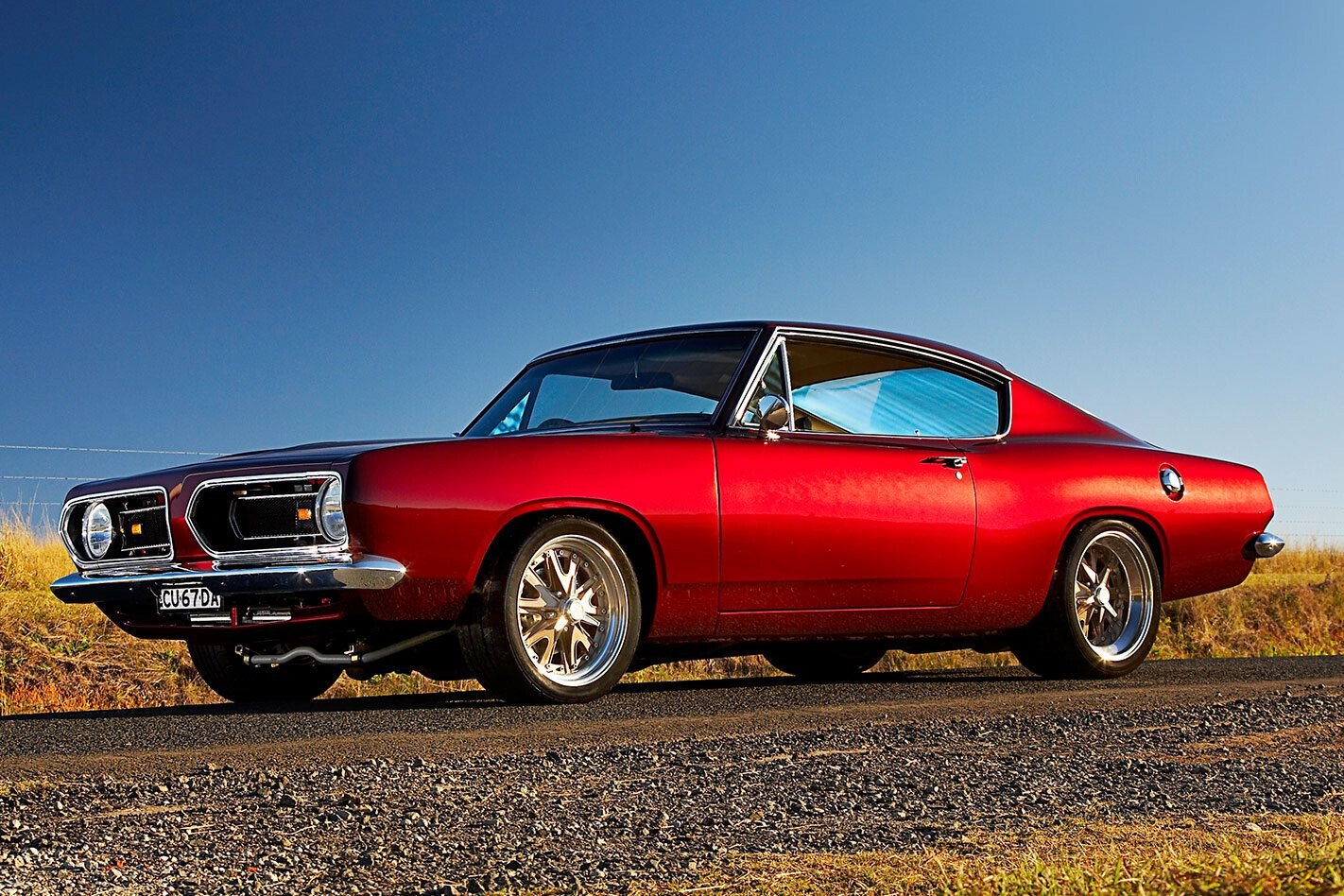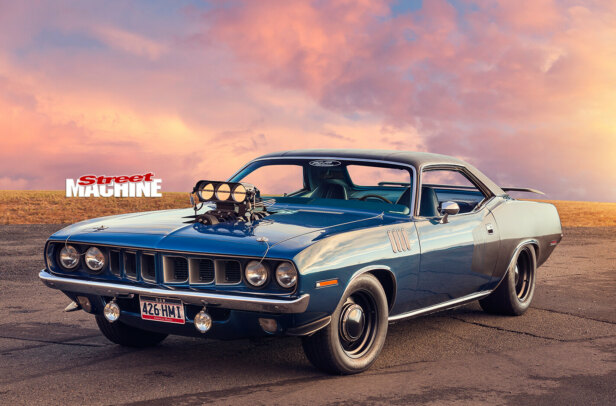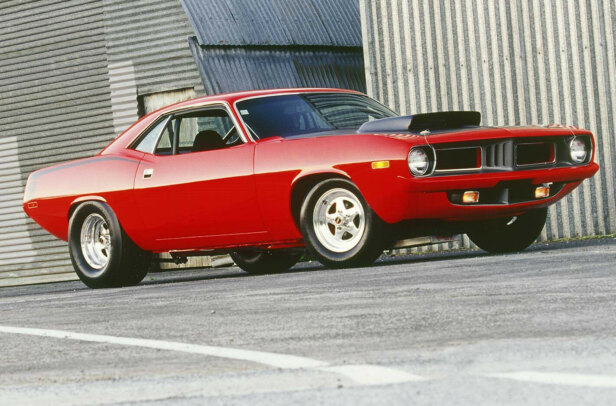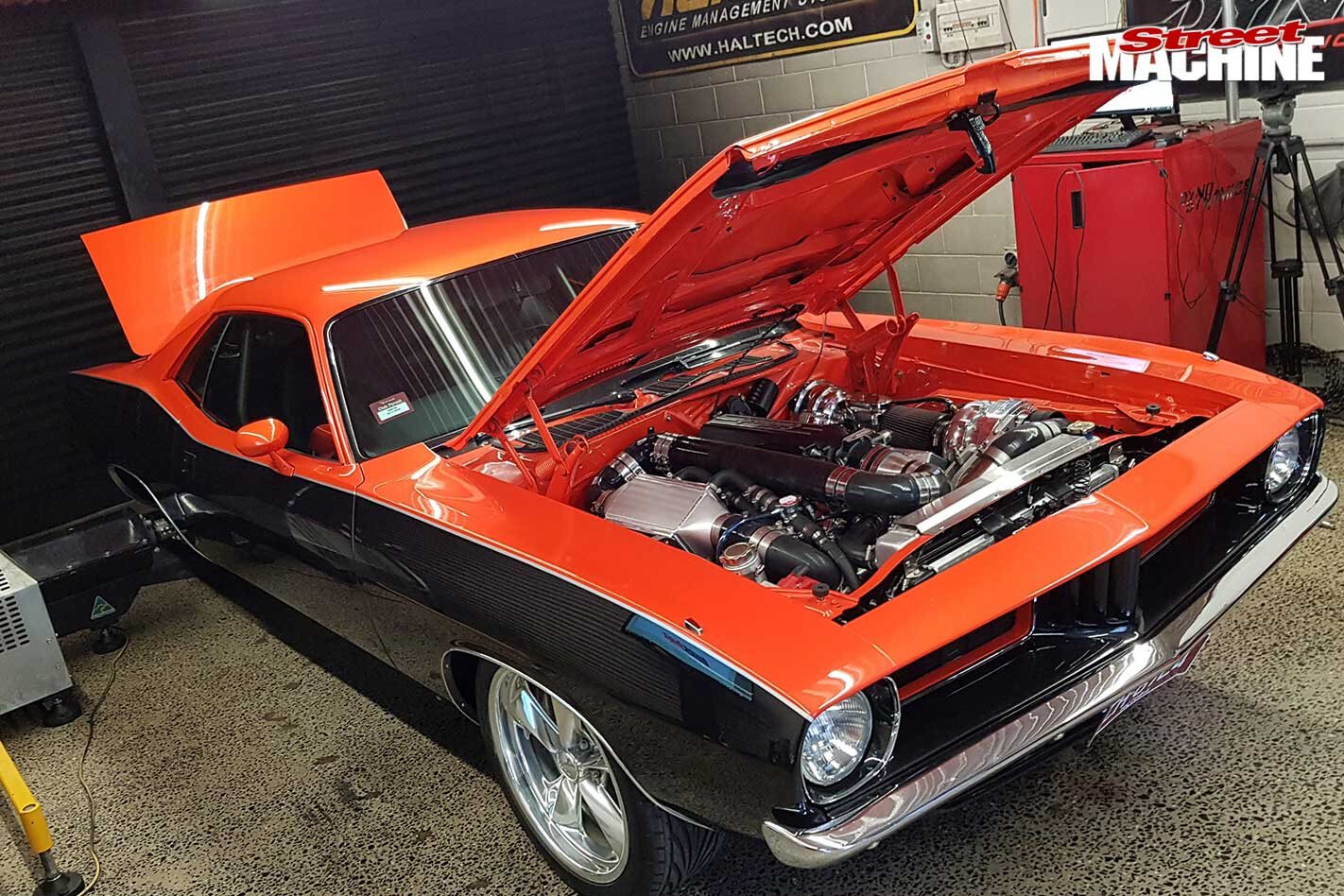Hemi ‘Cudas are legendary rides. Here’s one with a twist.
This article on Len’s ‘Cuda was originally published in the November 2011 issue of Street Machine
OVER the years Leonard Evans has had a string of cool rides in his driveway. Everything from XU-1 Toranas through to the latest HSVs, even a GTR Skyline and a big-block Corvette. But Len says he’s always wanted a Plymouth ’Cuda; preferably one with a Hemi up front.
“It’s always been top of the wish list. I’ve always been a car nut, as the leader of the opposition — the wife — would have it, but that’s played to her advantage too. She’s had plenty of top-of-the-line vehicles to drive around because of that.”
Finding the right car to kick off with is always a challenge, but this time it was made easier by a mate who rang Len with the news that he’d found a car.
“It was a 1967 Barracuda fastback,” he says. “It was red, unassembled and had no motor. It was perfect for me, which was lucky because my mate had already said that I’d buy it.”
Getting the car home involved a quick trip to Victoria, complete with an $800, six-point fine for speeding on a double demerit weekend. It seems he really couldn’t wait to get stuck into his new project.
Len’s wife Kathryn couldn’t wait for him to get started either. “She thought it looked like a piece of shit,” he says.
But rather than charge like a bull at a gate, Len took a more methodical approach. He came up with a plan based on the look he was aiming for, how fast he wanted to go, what driveline he wanted, how often he was going to drive it and how much he wanted to spend. He determined that first and foremost the car had to look good.
“To me the main thing is how the car sits over the wheels,” he says. “Its stance was the most important decision of all.”
Hemi power! The 354-cuber is a neat fit in the tight ’Cuda engine bay. JEM tuned the EMS Stinger to run the quad Weber-style EFI. It’s got the best of both worlds: grunt and drivability
Starting with a minimum legal ride height of 100mm, he wanted a wheel combination that would stand out, while looking good and staying cop-friendly.
“I decided that the wheels had to be period-correct but tough,” he says.
Halibrand copies from Oz Wheel were given the tick — massive 18×12 rollers on the back and 17x8s for the front — but actual sizes and offsets couldn’t be decided until the rear end was sorted. That required a rotisserie, so Len, a builder by trade, whacked one together out of wood in his own shed.
After stripping all the sound deadening from the underside, the shell was sent away to be blasted, then given a coat of primer when it returned. After that he hooked into the hard stuff, starting with a set of weld-in chassis connectors and cutting out the inner wheel tubs so they could work out the diff length and positioning for the four-link. Sydney Competition Warehouse was chosen to build the diff using 31-spline Moser axles and a limited-slip centre.
“I was reluctant to use a nine-inch,” Len says, “as I wanted to keep the Plymouth all-Mopar. But at the end of the day I was looking for reliability, serviceability and a variety of ratios.” In other words, a Ford LSD was given the job.
Moving forward through the drivetrain, the decision to go for a 727 Torqueflite was much easier. It’s as tough as anything else on the market and, with Len planning a Hemi up front, he needed something bulletproof.
X-Trim handled the tan leather, which extends to the custom dash panel that Len had laser-cut to suit the Auto Meter Nexus gauges. “They’re just spectacular at night,” he reckons
So has it got a Hemi? You betcha. But it’s not a 426 or even the classic 392. A slightly smaller 354ci Mopar powerhouse was chosen. And that’s not such a silly pick — back in 1956 the 354 Hemi was Chrysler’s premium engine and with up to 340hp, it was no slouch.
“It might seem to be an unusual choice, but I just wanted something that nobody had done,” he says of the powerplant.
The early Hemi was handed off to Dominator Engines for machining, before going to Len’s good mate Norm Campbell who slotted it all together. Given that these donks are insanely strong, the bottom end is mostly stock, except for a set of oversize Ross pistons and ARP bolts and studs. The Hemi heads were given a tickle-up by Ultra Torque and an Isky bumpstick was slipped up the guts for more grunt, but the really cool part sits on top. Four dual-throat Weber-style throttlebodies fill the wide valley of the Hemi V8.
While it would have been really cool to see eight tall injection stacks poking through the hood, the desire to keep things legal means the tubes had to stay short to fit under that modified bonnet.
Unfortunately for Len, centring the engine up front wasn’t exactly a bolt-in job. The early Hemi was never fitted to Chrysler’s 60s muscle cars so all the mounts had to be custom made and the ’Cuda was converted to rack and pinion steering to clear some space for the one-off mounts and headers.
All up it’s taken six years to get the ’Cuda to this point but the final hurdle was the hardest. When Len talked to an engineer about his plans way back when, he was given the tick of approval. But RTA rule changes along the way saw a reduction in how many engineers were actually able to sign off on the car.
With the original engineer out of the picture, he had to find someone else to give it the final nod. After a few changes, some more inspections, and the brake and sound tests, he finally had an engineer’s certificate in hand. But then the RTA threw up yet another roadblock.
Len cut the spare wheel well from the boot floor and expanded the fuel tank to fill the extra space. Back seat flips forward for extra space when needed
“Let me warn you,” Len says. “If you buy an imported vehicle, no matter how old, make sure you get a receipt with all the numbers plus the contact details of previous owners and the original import papers. I had to contact the previous owner and hope that after six years he had kept all the import documents. I was lucky that he had.”
On debut at Wodonga’s Chryslers On The Murray, the ’Cuda made a big impact with the Mopar faithful and found its way straight into the Top 10. That’s a pretty good result considering there were 700 other pimped and pretty Mopars all vying for the honour. But we had to ask: after all this time has it been worth the wait?
“I don’t know yet,” he laughs. “I’ve been a bit crook lately so I haven’t had the chance to really drive it. But now that it’s all sorted, runs really well and starts easily, I can’t wait to put some miles on it.”
KILLER FISH
DON’T know your Barracuda from your barramundi? Here’s a quick guide:
1. Originally intended to be called the Panda, the first Barracuda ran from 1964-66 and was basically a fastback Valiant with a crazy wraparound rear window. It was available with either the slant six or the 273 V8, but the car failed to take on the wildly popular Mustang in the sales race.
2. The second generation arrived in ’67 and was a much more aggressively styled car, wth fastback, notchback and convertible bodies. The new 383ci big-block became an option, and in ’68 the legendary 275hp 340ci small-block and dragstrip-only 426 Hemi joined the line-up. It was the start of a legend. The original Hemi ’Cuda, along with its cousin, the Hemi Dart, dominated Super Stock drag racing throughout the late 60s and early 70s.
3. When Plymouth unveiled the 1970 Barracuda it finally had a car that looked pretty enough for the masses but packed plenty of grunt for the hardcore, with the 225, 318, 340, 383, 426 Hemi and 440 all on offer. In 1974 the third generation Barracuda was phased out — 10 years to the day after it was introduced — but it’s still recognised as one of the quickest regular production cars to ever hit US showrooms.
LEN EVANS
1967 PLYMOUTH BARRACUDA
Colour: PPG Sparkling Burgundy
ENGINE
Engine: Chrysler
Block: 354 Hemi
Throttlebodies: Quad Weber-style EFI
Intake: Hot Heads
Heads: Ported
Pistons: Ross
Crank: Stock
Rods: Standard
Cam: Isky hydraulic
Ignition: MSD
ECU: EMS Stinger
Exhaust: Custom headers, twin three-inch system
TRANSMISSION
Transmission: Torqueflite 727, Stage-III shift, CRS adaptor
Converter: 2800rpm
Diff: Nine-inch LSD, 3.55 gears, Moser 31-spline axles
SUSPENSION & BRAKES
Brakes: Wilwood four-spot calipers (f&r)
Springs: HD torsion bar (f), coil-overs (r)
Shocks: Koni (f), Spax (r)
Suspension: Stock (f), triangulated four-link (r)
Steering: GM power rack and pinion
Bushes: Nolathane
WHEELS & TYRES
Rims: Oz Wheel Halibrand copies, 17×8 (f), 18×12 (r)
Rubber: Toyo, 235/45 (f), 335/35 (r)
INTERIOR
Wheel: Wood rimmed
Column: Ididit adjustable
Seats: Leather trim
Gauges: Auto Meter Nexus
Shifter: Hurst Quarter Shift
Stereo: Sony CD, Sony 6in (f), Sony 6x9in (r)





Comments